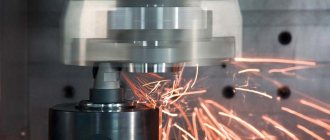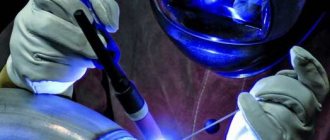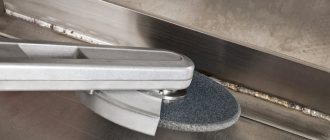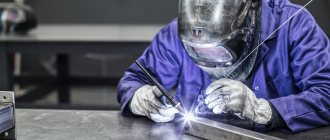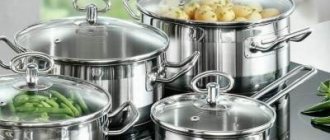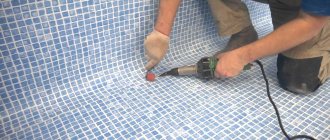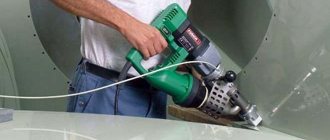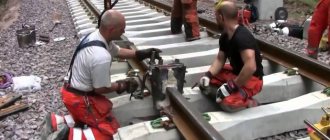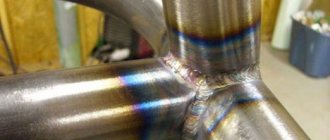The process of welding stainless steel with ferrous metal causes difficulties even for experienced craftsmen. This is due to the physical and chemical properties of the materials.
To create a strong weld, the correct choice of operating parameters of the apparatus, brand of electrodes, and filler wire is required.
Common problems with weldability of stainless steel at home
Difficulties may arise when welding stainless steels:
- Low thermal conductivity of the material. Compared to ferrous metal, this parameter is 2 times less for stainless steel. When heated, parts do not give off heat to the environment, but accumulate it within themselves. A sharp increase in the temperature of the treated area contributes to the appearance of through defects. Reducing the supplied current solves this problem.
- Increased linear expansion. When the weld seam cools, shrinkage occurs, which can break the connection and lead to the appearance of cracks. Increasing the distance between the workpieces helps eliminate this drawback.
- Electrical resistance. This parameter is also high for stainless steel. Resistance affects the electrode, causing it to overheat. The length of the consumable is reduced to 35 cm.
- Changes in physical characteristics under high temperature exposure. When overheated, stainless steel loses its anti-corrosion properties, turning into simple steel. The problem can be solved in different ways, for example, by conducting the welding process in a gas environment or cooling the elements being connected with water.
What is stainless steel
At its core, stainless steel is steel that has been improved by adding impurities to make corrosion impossible. The list of such additives is quite wide: copper, nickel, chromium, manganese, titanium, sulfur, molybdenum, silicon and some others. Due to the combination, the steel significantly changes its original properties and appearance.
The advantages of stainless steel are obvious:
- High strength;
- Good resistance to high temperatures;
- High resistance to corrosion and environmental influences;
- Aesthetically attractive appearance.
Kinds:
Austenitic steels. They contain at least 20% chromium and 4.5% nickel.
Duplex steels. Their chromium content reaches 25%, 1.5% nickel and a slight admixture of nitrogen.
Ferritic steels. Up to 29% chromium is allowed in their composition.
Martensitic steels. Their chromium content is insignificant, no more than 13%, and nickel maximum 4%.
Multicomponent steels. Minimal amounts of chromium and nickel and include a wide range of other enhancing impurities.
In this case, chromium is a reinforcing component, due to which strength and corrosion resistance increase significantly. Cold deformation is simplified and weldability, appearance and wear resistance are improved.
Stainless steel markings:
- A number indicating the percentage of carbon;
- Letter designations that give an idea of what kind of impurity is contained in this alloy: X-chrome, N-nickel, etc. After them come digital designations of the percentage of impurities.
Features of welding dissimilar steels
Ferrous metal and stainless steel have different chemical compositions and physical properties. The process of welding parts made of dissimilar materials is associated with the following difficulties:
- The weld seam is the weakest point of a metal structure. This is due to the difference in linear expansion coefficients. After solidification of the melt, internal stress remains, reducing the resistance of the joint to loads.
- The joint melts unevenly, which is due to the difference in thermal conductivity. This negatively affects the strength of the weld.
- Carbon atoms migrate, worsening the anti-corrosion properties of the metal. The seam quickly becomes rusty and destroyed.
Electrodes used
Having understood the welding technology, you can move on to the question of what electrodes and filler wire should be used for welding ferrous metal and stainless steel. The wire used in the process of welding two different steels must contain at least 30% of the base material. The degree of alloying must be the same or higher than that of the metals being welded. In the case of stainless steel and black, the main material is stainless steel (as it has the highest degree of alloying). The rest of the filler material is nickel and manganese.
Electrodes for welding
In principle, a good welded joint for not very critical structures can be obtained without the use of special consumables. Most often, a stainless electrode or a stainless filler wire is used to connect stainless and ordinary steel. Such electrodes contain an increased amount of alloying components, which make it possible to compensate for their burnout during the heating process.
If you need to weld any critical structure, you should pay attention to special transition electrodes for welding dissimilar or difficult-to-weld steels. When using them, a special intermediate (or buffer) layer is deposited, which allows the parts to be connected
The most commonly used electrodes are OZL-312 (in cases where the chemical composition of steels is generally unknown) and NII-48G.
Technology and operating rules
The correct choice of method for welding ferrous metal to stainless steel helps to obtain a strong, durable connection.
Suitable modes
The following technologies are most often used to connect parts made of dissimilar materials:
- electric arc welding with fusible electrodes;
- work in an argon environment with or without infusible tungsten rods and filler wire.
To obtain a high-quality weld using the electric arc method, electrodes are used for welding stainless steel.
The argon arc method involves the use of steel wire with alloying additives: nickel, chromium, manganese. The suture material should contain more stainless steel, the recommended concentration of this metal is 40-60%.
Electrodes for stainless steel welding and their classification
The stability of the welding arc and the quality of the resulting seam depend on the correct choice of rods. To work with ferrous metal and stainless steel, the following brands of adapter electrodes are used:
- OZL-25B, used for welding parts made of heat-resistant steels;
- NIAT-5, used for working with austenitic materials;
- TsT-28, intended for welding nickel-containing alloys;
- E50F, used for working with heat-resistant metals.
We recommend reading: How to weld stainless steel with electrodes
For currents up to 60 A, rods 2 mm thick are used. If the value reaches 80 A, the electrode diameter should be 3 mm.
What are ferrous metals
They are rightfully considered the most popular. They account for more than 90% of all metals used in production. Essentially it is iron and its various alloys enriched with carbon. It is the percentage of carbon that determines the final version of the acquired properties: cast iron or steel.
Cast iron contains 1.7% or more carbon; in steels the carbon content varies from 0.2 to 1.7 percent. For qualitative improvement, it is customary to use alloying additives (from the Latin “to bind”), which are other alloys, metals and chemical elements.
The most common alloys are chromium, silicon, copper and nickel.
According to the name, ferrous metals have a dark gray, almost black color. The main properties include: fairly high melting temperatures, high strength and hardness.
It is customary to distinguish:
- Ferrous metals: iron, cobalt, nickel, manganese;
- Refractory metals with a melting temperature of 1539 degrees.
Properties:
- Strength;
- Hardness (the ability of a metal to resist against a harder embedded sample);
- Elasticity (the possibility of returning to the original form);
- Viscosity (impact absorption);
- Plasticity (the ability to change without breaking).
Having considered the main characteristics of stainless steel and ferrous metals, we can move on to consider the question: is it possible to weld stainless steel with ferrous metal. The main difficulty lies in the foreignness of these steels. In order to weld stainless steel with ferrous metal, you will need a carefully selected welding mode, good technical equipment and the professionalism of the specialist performing the process.
Methods of welding ferrous metal and stainless steel
Manual and semi-automatic machines are used to join parts made of different metals. The process is carried out both with and without the supply of protective gas.
Semi-automatic machine
When using this technology, the elements to be connected require preparation. Before welding, perform the following steps:
- the areas adjacent to the future seam are cleaned with an iron brush to a metallic shine;
- chamfers are removed from the edges of thick workpieces;
- degrease surfaces with acetone, alcohol or gasoline;
- dry the edges by heating them with a burner;
- To eliminate internal stress, parts are heated to 200 °C.
For welding at home, a semi-automatic machine with a power of up to 10 kW is sufficient. Such devices are designed for joining workpieces up to 3 mm thick. When setting up the unit, the voltage is set to 19-25 V. The recommended supply speed of consumables is 300-400 m/h. The current strength is selected depending on the thickness of the metal. By increasing or decreasing this parameter, the degree of penetration, the length of the electric arc, and the shape of the seam are adjusted.
When working, observe the following rules:
- The process is carried out with a current of reverse polarity.
- The torch is installed at an angle to ensure the required penetration depth and width of the weld pool. The wire should protrude no more than 12 mm.
- Gas flow should be 6-12 m³/hour. To remove excess moisture, the substance is passed through a desiccant.
- The electrode is calcined at +200 °C before use.
- To protect adjacent areas from melt splashes, they are treated with an aqueous solution of chalk.
- Welding begins by retreating 5 mm from the edges of the parts. This prevents cold cracks from appearing.
- The electrode is guided smoothly along the connection. Transverse movements are unacceptable. The melt must not leave the protective environment.
How to cook with an electrode
Inverters are used to connect stainless steel and ferrous metal workpieces in domestic conditions. The devices are powered from a 220 V network; their compact dimensions make them easy to move. The welding process is carried out as follows:
- Clean the treated surfaces from rust, grease and dust. Clean the metal until it shines.
- The edges of thick workpieces are cut with a grinder or file. This ensures a high degree of penetration and filling of the weld pool.
- Thin-walled parts are compared and welded in several places. Products with a thickness of more than 5 mm are heated to 150 °C. At home, a blowtorch is used for this.
- Excites an electric arc. To do this, bring the electrode to the surface and touch it several times. Welding is carried out with a short arc.
- The welding is completed, forming a lock that prevents the appearance of cracks and burns.
- Wait for the seam to cool naturally. Coercive methods cannot be used.
- Clean the connection from slag using a hammer. Polish and grind the seam.
We recommend reading: How to cook stainless steel with a semi-automatic machine
In a gas environment
The process is carried out using infusible tungsten electrodes. Due to the high cost of the work, the method is rarely used in home workshops. However, it helps to obtain the highest quality welded joint in comparison with other technologies. The argon method is used to repair damage in gas and water pipelines. Welding ferrous metal with stainless steel is carried out with direct current.
Gas begins to be supplied 5-10 seconds before the electric arc appears. The entry of air into the weld pool leads to oxidation and deterioration of the anti-corrosion properties of steel. During operation, zigzag movements of the electrode are unacceptable. They are capable of disturbing the gas space.
To protect the underside of the seam, blowing is used. After welding is completed, gas continues to flow for 15 seconds. This increases the strength of the seam.
Equipment and tools for welding stainless steel with ferrous metal
How to weld stainless steel with ferrous metal ? First of all, for this you need a set of equipment:
Of course, to weld stainless steel and ferrous metal, you need an inverter welding machine operating on direct current. Welding modes are selected depending on the thickness of the part.
When choosing electrodes, the specificity of the coating should be taken into account. The main types are: OZL-25B (high heat resistance); NIAT-5 (austenitic materials); TsT-28 (nickel-containing steels); E-50F (similar to OZL-25B).
The alloy metal in the wire must contain higher values than that of the material being welded. In other words, the higher the content of nickel, manganese and chromium in the wire, the stronger the connection will be.
Of course, it is important to remember about the correct setup of welding equipment and materials. How to choose the right operating mode:
- If the thickness is 1 millimeter, usually the direct current does not exceed 58-60 Amperes (electrode diameter is 2 millimeters);
- In the case of a thickness of 2 to 3 millimeters, the current can reach up to 75-80 Amperes (electrode 3 millimeters);
- When the thickness reaches 4 mm, use a current of up to 125-128 Amperes (4 mm electrode);
If the DC current reaches too high a level, there is a risk of damage to materials during the welding process.
Selecting Electrodes
In order to reliably weld a product made of stainless steel to a part made of ordinary ferrous metal, a number of important nuances should be taken into account. First of all, they relate to the choice of filler wire of a certain chemical composition. The metal of the filler wire, the degree of alloying of which must be higher than the similar parameter of the material of the product being welded, must necessarily contain elements such as manganese, nickel and sometimes chromium.
Brands and chemical composition of high-alloy welding wire (click to enlarge)
An important condition for the formation of a high-quality welded joint is the presence of a certain proportion of base metal in the composition of the weld being formed. Depending on the welding technology used, the amount of base metal in the weld material can be 30–40%.
Before welding a stainless steel workpiece with a ferrous metal part, you should find out the chemical composition of the steels being welded in order to select the correct type of electrodes.
Dissimilar materials that need to be joined by welding may differ in a number of parameters:
- ability to form permanent connections (weldability);
- thermal conductivity;
- mechanical characteristics;
- degree of alloying;
- chemical composition.
In this case, steel alloys, the products from which must be welded together, may belong to one of the following categories:
- carbon;
- low alloy;
- heat resistant;
- alloyed;
- characterized by a high degree of alloying - highly alloyed.
Approximate selection of welding material depending on the purpose of the weld
The main problem associated with welding dissimilar steels (stainless steel and ferrous metals) is the formation of cracks in the formed weld. Very often, in order to avoid such a problem, specialists use high-alloy electrodes for welding stainless steel products with parts made of ferrous metals, which allow them to form a weld with high strength parameters.
The result of arc welding of stainless steel with black steel with an OZL-6 electrode. The seams, although darker, have not rusted for several months
In general, for welding stainless steel products with parts made of ferrous metals, several main types of electrodes are used:
- E50A – for steels characterized by high heat resistance;
- OZL-25B – for steel alloys classified as heat-resistant;
- NIAT-5 – for steels with an austenitic internal structure;
- TsT-28 – for steel alloys containing a significant proportion of nickel in their chemical composition.
Which welding technology is better to choose?
When deciding how to weld stainless steel to ferrous metal in a home workshop, welders prefer cheap methods. However, the most durable seam is obtained using expensive argon arc technology. Such equipment is rarely found in a home workshop. Purchasing the device is not advisable.
Inverters are cheaper. Stable operation and high strength of the resulting seam make this equipment preferable for home craftsmen.
Manual arc technology is only suitable for forming horizontal connections. When exposed to high temperatures, the steel melts and the weld pool moves.
Bottom line: what to consider when welding stainless steel and ferrous metal
Thus, answering the question: is it possible to weld stainless steel to ferrous metal , it is worth noting that despite the complexity of the process, it is quite feasible. But you must strictly adhere to the basic rules:
- Correct identification of all impurities and type of metal;
- Competent selection of electrodes;
- Selection of the optimal required welding mode, depending on the thickness of the workpiece and the type of steel.
- All welding work is carried out only when DC current is supplied;
- To obtain a high-quality connection, surfaces are usually fixed horizontally;
- It is necessary to take into account the difference in melting and fluidity temperatures of metals. Thus, stainless steel has faster fusibility than ferrous metals;
- Different indicators of linear expansion that change during the cooling process require close attention. Otherwise, the size of the two parts being connected that changes after cooling can lead to damage to the connection;
- Do not allow the electrode to overheat.
Taking into account all the listed nuances and having studied in detail the properties and composition of the surfaces being processed, it is possible to achieve a reliable, high-quality connection that retains all the basic positive properties of steels.
The basis of work in the case of welding dissimilar metals is to establish a clear boundary of admissibility and optimization. The only thing that can be added to all of the above is the need to comply with safety measures and all technological criteria.
Necessary Precautions
When choosing any welding technology, observe the following safety rules:
- Do not use faulty devices. The main units of equipment are checked before starting work. The wires must not be damaged. If necessary, the cables are replaced.
- Only new electrodes with intact coating are suitable for use. The use of cracked rods is unacceptable.
- The workplace is set up in advance. Flammable liquids and materials, as well as foreign objects that could hinder the process, are removed from the welding zone.
- When working, use a welding mask, a special suit, gloves, and tarpaulin boots. A dielectric mat is laid near the equipment, eliminating the possibility of electric shock to a person.
- The room is equipped with a powerful ventilation system.
- The work is carried out on a special table. It is not recommended to keep parts suspended.
- When using inert gas or oxygen, there should be no traces of oil on the welding table.
We recommend reading: How to cook stainless steel in an argon environment
Security measures
Welding work is carried out in strict compliance with safety regulations:
- Never use faulty equipment. Check the device in advance, inspect the working elements and wires for possible breakdowns.
- The electrodes must be new, with the working layer intact. Cracked rods should not be used.
- Prepare your workplace in advance. Remove all flammable mixtures away and clear the table of unnecessary objects that may interfere with welding work.
- Welding is considered a harmful technological process. Therefore, you need to use a welder’s mask, protective overalls, gloves, and durable shoes.
- Place a rubber mat under your feet to prevent electric shocks.
- The room in which welding work is carried out must be equipped with a good ventilation system.
- For convenience, it is advisable to carry out work on a metal work table.
When working with cylinders filled with inert gases or oxygen, it is necessary to wipe off any oil leaks in the work area.
Any welder knows how difficult it is to weld stainless steel parts together. The process becomes more complicated if you need to connect stainless steel with ferrous metal. Therefore, it is necessary to accurately determine the components of materials, select electrodes, and the operating mode of the device. During the work process, you need to take into account the advice of professionals.
Popular electrode manufacturers and selection of other equipment
Many companies offer welders a wide range of electrodes used in welding dissimilar metals. The leading manufacturers of rods are:
- ESAB;
- Losinoostrovsky Electrode Plant;
- "Kirov Electrode Factory";
- Quattro Elementi;
- "Special electrode";
- Lincoln Electric.
INVENTOR SELECTION CRITERIA
- When working with products less than 1 mm thick, the optimal choice would be electrodes with a diameter of no more than 2 mm. With a current of no more than 60 amperes.
- Workpieces from 2 to 3 millimeters are welded with 3 mm electrodes, with a current equal to 80 amperes.
- Metals with a thickness of over 4 mm are welded with 4 mm electrodes, and the current strength is set from 100 to 130 amperes.
Before starting work, it is recommended to calcinate the electrodes in ovens at a temperature of at least 200 degrees and with an exposure time of at least 1 hour. All work is carried out using direct current and using nickel-plated electrodes. The main rod is made of high alloy steel. Welding is carried out using the method of fusing edges, and the grip is carried out with a large supply of ferrous metal. Before processing begins, all surfaces are carefully treated to remove rust and dirt. The quality of the connection is improved by using flux in the working surface area.
Features of working with thin stainless steel
When welding thin-walled materials, appropriate skills are required. It is recommended to choose one of 2 methods:
- Welding with special electrodes. The current strength should be less than when working with ordinary steel. The advantage of the method is that there is no need to use gas cylinders or purchase auxiliary tools. The disadvantage is the low quality of the resulting seam.
- Welding in argon environment. The method is considered safer and more effective. The gas protects the treated areas from oxygen, which eliminates the formation of through defects and makes the seam uniform.
Welding process
Once the equipment is set up and all recommendations are taken into account, you can proceed directly to welding.
To avoid the appearance of deformation and cracks, a gap is left between the parts along the entire length for expansion. The parts are secured in a vice or other way and clamped in several places.
You need to start with minimal consumption of shielding gas. Turn off the wire feed and adjust the gas flow rate to operating mode using the valve on the reducer. Then direct the gas flow to the workpiece and blow through its surface in literally 3-5 seconds.
At the beginning of welding, you need to look at the seam. If pores form, increase the gas supply until they no longer appear. Gas consumption must be adjusted to economical mode. So that the quality of the seam does not suffer.
You need to start cooking 5-6mm away from the edge to prevent cracks from forming. The torch nozzle should be angled slightly back in the direction of the seam and at a height of 10-12mm above the welding joint.
If the angle is tilted forward, the weld width increases and the penetration of the welding arc decreases, which is good for thin sheets.
Welding speed
The speed at which the electric arc moves along the welding site is controlled by the welder. Too high - it can cause a lot of splashes and melting of the metal, while the protective gas does not have time to escape and pores form. Insufficient speed is the reason for changes in the penetration of the welding arc into the parts being welded.
You need to cook with a short arc - this is when the distance between the end of the wire and the surface of the molten metal is 0.5-1.5 mm. Boiled in this way, the seam has the correct outline, a smooth and convex surface.
Another method of welding thin parts is pull-off welding, i.e. short circuits of the arc gap. Press the trigger and release, and gradually fill the joint with a thread seam (rollers).
If the device has a pulse function, then it is better to work on it. Pulses generated by a short circuit in the welding machine are used to melt the metal.
When welding thin (up to 3mm) stainless steel with a semi-automatic machine, guide the torch nozzle along the seam, avoiding transverse movements. Otherwise, there is a possibility of molten metal leaving the protective environment zone. It is better to weld thin parts in a vertical position, moving from top to bottom.
If two workpieces are of different thickness, then keep the nozzle on the thick one. With an instant movement, move the torch to the thin workpiece and return to the thick one again. Otherwise, the thin metal will burn out.
To avoid serious defects during welding, it is worth using ceramic pads, which are self-adhesive tape. They are most suitable for working with thin parts, as well as in awkward spatial positions.
Pipeline welding
To connect pipes made of different materials, electrodes with rutile or basic coating are used. With fusible consumables, work is carried out with a current of reverse polarity. Welding pipes with constant parameters has the following advantages:
- Possibility of use when working with thin-walled pipes;
- high quality seam;
- ease of execution;
- minimum amount of splashes generated during operation.
When using non-fusible tungsten electrodes, set straight polarity. This method of welding pipes has the following positive characteristics:
- reliable protection of the oxygen weld pool;
- stability of the electric arc;
- corrosion resistance of the seam.
Overview of methods
Stainless steel is quite often welded using argon arc technology. Gas consumption per minute averages only 8 liters (using the TIG technique). Of course, the specific result is directly influenced by the characteristics of the work performed and other nuances. The use of a special “lens” significantly reduces gas consumption. For operation, the use of universal tungsten electrodes is recommended. The argon arc technique allows you to confidently handle even very thin workpieces. In principle, other protective gases can also be used. But they turn out to be less practical and are used less frequently.
A mandatory element of preparation is, of course, cleaning the workpieces. Even the slightest dirt should not be allowed on the joining edges. Deposits of any other substances, including paint, are also unacceptable. A copper plate is placed under the metal, which will allow heat to be removed as efficiently as possible. But this plate will also have other tasks - holding the melting metal in place, rigidly attaching the workpieces to be connected.
The electrode and wire can only be moved along the seam line. The slightest deviations in the transverse plane will disrupt the entire process. At the same time, make sure that the wire does not leave the gas-protected area. Blowing the back side of the workpiece with an inert substance will allow you to achieve improved quality. True, in this case one cannot count on saving gas - on the contrary, its costs will rise noticeably.
Touching the tungsten electrode to the surfaces of the workpieces, even when initiating the arc, is contrary to technology. It is best to ignite an arc on a plate made of graphite or coal. Then it is immediately transferred to metal. The contactless version will require an oscillator. Stopping the gas supply immediately after welding is completed is a serious mistake: it must be supplied for another 10–15 seconds!
Sometimes stainless steel is joined using a cold method. For this purpose, a universal adhesive is used to ensure reliable joining. Of course, it will not be possible to provide the same strength as with fire or electric welding. But the advantages compared to other adhesive mixtures are undeniable. In addition, the work requires relatively few tools, and the preparation of the proprietary composition itself will take about 5 minutes (plus you will have to wait a few more hours for setting).
The glue is very flexible, it is easy to form patches of any configuration from it. It becomes possible to replace the loss of parts and recover material. Since the adhesive usually contains a metal filler, the properties of the seam are as close as possible to the properties of solid metal. Of course, it will conduct electricity - unless you use a formulation without metal filling.
The permissible temperature must be taken into account. Cold welding is not very suitable, to put it mildly, for car engine parts, exhaust pipes or chimneys. In a number of other situations, prolonged setting is a serious disadvantage. Professionals recommend purchasing the largest possible packages for frequent use of cold welding, because they are more economical.
Working with heat-resistant stainless steel has important features.
During such work, maximum attention will have to be paid to the fight against microscopic and macroscopic cracks. Each material is carefully studied and it is found out what temperature should be used when welding it.
In some cases, it is even necessary to conduct “full-scale tests” with samples. All parts are hardened at temperatures up to +1100 degrees, after which they are cooled.
Sometimes you have to weld food grade stainless steel. For this purpose, electrodes of the TsL-11 model are most often used. This device allows you to weld metal in any spatial position and even use currents of reverse polarity. It is also compatible with chromium-nickel alloys and compounds that are most resistant to corrosion.
Both food grade and other steels are often treated with alternating current. This method is used both in domestic conditions and in large-scale industry. This is what is in demand when creating metal pipelines. The cost of the devices used can vary greatly. Overall they are simple and versatile.
Control of welded joints
To assess the strength of the connection between iron and stainless steel, the following methods are used:
- Treating the seam with kerosene. If liquid comes out from the reverse side, the connection is poor quality.
- Using acetone. It is applied in the same way as kerosene. Drops appearing on the reverse side indicate the presence of through defects.
- Hydraulic method. Used in industrial environments. After supplying water under pressure, inspect the connection.
- Ultrasound methods. They are used when high demands are placed on the quality of metal structures.
How to check connection quality
The resulting seam is checked after it has completely cooled. First of all, a visual inspection of the surface is carried out for the presence of cracks or burnt parts. If the tightness of the connection is required, then the test is continued using kerosene or ammonia. Using kerosene, microcracks that may have arisen during the welding process are checked. To do this, a chalk solution is applied to one side of the seam being tested, and kerosene tinted with dye is applied to the other side. If the chalk solution has changed color, the seam is not sealed. In the place where staining has occurred and there is no seal. The coloring effect is based on the capillary penetration of kerosene through microcracks. Kerosene was also not chosen by chance; this liquid has very high fluidity. Testing with ammonia is no different from testing with kerosene, only in this case the chalk solution is replaced with special indicators that change color.
Seam connection quality
Critical closed structures can also be tested for tightness and strength at the same time. For this purpose, artificially created hydraulic pressure is used.
It is important to remember that if there is a suspicion of an obviously weak weld, then using this method is strictly prohibited.
Checking the quality of the seam will allow you to be sure that you managed to weld the parts well.
Useful tips
Experienced welders give novice welders the following advice:
- When welding dissimilar metals, it is advisable to use consumables containing nickel. Before starting work, the rods are calcined for an hour.
- The welding machine must produce direct current.
- You cannot skip the pre-processing stage of parts. If dirt or rust is present, the seam becomes brittle.
- When gas welding, forced cooling methods cannot be used. The part must cool naturally.
- The application of flux helps to increase the strength of the connection.
- The tips of non-fusible electrodes need to be sharpened regularly.
- When welding, try to capture as much ferrous metal as possible. This helps establish a strong molecular bond.
- The electrode must be guided slowly and carefully.
Following the recommendations helps you quickly master the methods of welding parts made of dissimilar metals.
Advantages and disadvantages
The undoubted advantages of semi-automatic welding of stainless steel:
- High performance combined with high-quality connection;
- low smoke emission, which protects health and the environment;
- slight metal spattering due to automatic wire feeding;
- versatility - you can weld workpieces of different thicknesses, as well as dissimilar metals.
One significant drawback is the bulky gas cylinder. These are additional costs for its acquisition and inconvenient movement.
The spread of the method became possible with the development of technology and process automation. Mainly used in industry for large-scale production. Working with a semi-automatic welding machine, although it requires certain knowledge and skills, still remains one of the popular types of metal processing. You can learn more about how to operate a semi-automatic welding machine in our article.
